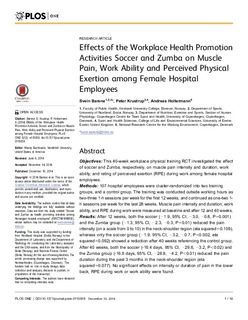Effects of the Workplace Health Promotion Activities Soccer and Zumba on Muscle Pain, Work Ability and Perceived Physical Exertion among Female Hospital Employees
Original version
Barene, S., Krustrup, P. & Holtermann, A. (2014). Effects of the Workplace Health Promotion Activities Soccer and Zumba on Muscle Pain, Work Ability and Perceived Physical Exertion among Female Hospital Employees. PLoS One, 9(12), e115059. doi: 10.1371/journal.pone. 0115059 http://dx.doi.org/10.1371/journal.pone.0115059Abstract
Objectives
This 40-week workplace physical training RCT investigated the effect of soccer and Zumba, respectively, on muscle pain intensity and duration, work ability, and rating of perceived exertion (RPE) during work among female hospital employees.
Methods
107 hospital employees were cluster-randomized into two training groups, and a control group. The training was conducted outside working hours as two-three 1-h sessions per week for the first 12 weeks, and continued as one-two 1-h sessions per week for the last 28 weeks. Muscle pain intensity and duration, work ability, and RPE during work were measured at baseline and after 12 and 40 weeks.
Results
After 12 weeks, both the soccer (−1.9, 95% CI, −3.0, −0.8, P = 0.001) and the Zumba group (−1.3, 95% CI, −2.3, −0.3, P = 0.01) reduced the pain intensity (on a scale from 0 to 10) in the neck-shoulder region (eta squared = 0.109), whereas only the soccer group (−1.9, 95% CI, −3.2, −0.7, P = 0.002, eta squared = 0.092) showed a reduction after 40 weeks referencing the control group. After 40 weeks, both the soccer (-16.4 days, 95% CI, −29.6, −3.2, P<0.02) and the Zumba group (-16.6 days, 95% CI, −28.9, −4.2, P<0.01) reduced the pain duration during the past 3 months in the neck-shoulder region (eta squared = 0.077). No significant effects on intensity or duration of pain in the lower back, RPE during work or work ability were found.
Conclusions
The present study indicates that workplace initiated soccer and Zumba training improve neck-shoulder pain intensity as well as duration among female hospital employees.
Trial Registration
International Standard Randomized Controlled Trial Number Register ISRCTN 61986892.
Description
This is an Open Access article licensed under the Creative Commons Attribution License 4.0 and originally published in PLoS One. You can access the article by following this link: http://dx.doi.org/10.1371/journal.pone.0115059.
